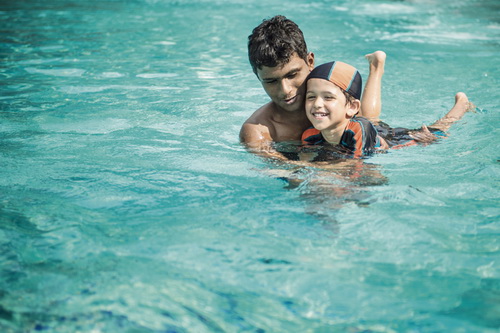Whether you’re staying in Beijing or taking off for more exotic climes this summer, safety on or off the water is sure to be high on your list of concerns. For tips on keeping your family safe this summer, we spoke to Dermatologist Dr. Jenny Sun from Vista Medical Center and Family Physician Dr. Mijke Vankan from Oasis International Hospital.
General Water Safety
When it comes to water safety, Dr. Mijke Vankan of Oasis International Hospital encourages parents to adopt a common sense approach. Safety measures include making sure your kids always buddy up when they go swimming, maintaining adult supervision at all times (even when there are lifeguards), drinking plenty of water, and using sun protection.
According to the American Red Cross, kids under 1 most often drown in bathtubs, buckets or toilets; children aged 1-4 most often drown in home pools; and older children most often drown in natural water sources. “Kids can drown in very shallow water, as little as 6cm,” says Dr. Vankan. “Even in bathtubs, you shouldn’t leave young children by themselves. They can easily turn, hit their heads, and fall down. You should be able to reach them within a step.”
Public Pools
Generally, Dr. Vankan says that parents should always be aware of potential pathogens at public pools, fountains, and hot tubs. “Although most water is safe, you should always make sure not to swallow it – especially if it smells or you don’t have a good feeling about it,” she says. However, special vaccinations aren’t necessary.
A common concern is the effects of chlorine, a disinfecting agent that can be absorbed into the body through inhalation and via the skin. Even low-levels of chlorine can cause skin and eye irritation, a sore throat, and coughing. “If you swallow too much, you might feel nausea and vomiting,” says Dr. Vankan.
Indoor pools with inadequate ventilation put swimmers at a higher risk of chlorine exposure. That being said, most swimmers don’t experience adverse affects from chlorinated water alone. It can be hard to tell whether pools in China are adequately maintained, but Dr. Jenny Sun of Vista Medical Center says a good indicator is the smell. If the pool smells strongly of chlorine, chances are you should avoid it.
If your child isn’t potty-trained, use only swimming diapers that have been consumer-tested and designed specifically for use in the water. “You can give an infection to other people if your child lets stools go in the water,” says Dr. Vankan. “That would not be a pool I’d want to swim in. Change swim nappies regularly and not poolside.”
Always take a hot shower and moisturize after visiting a public pool. If you’re especially sensitive to chlorine, there are lotions applied before swimming that are specially formulated to block the substance. In addition, thoroughly dry your feet after showering and wear flip-flops in the changing room. “Fungal infections like athlete’s foot grow in wet and warm conditions,” says Dr. Sun. Drying the feet also helps prevent contagious infections like plantar warts, which are caused by the HPV virus.
Beaches
There’s no basis to the old saying that you should wait an hour after eating to go swimming, says Dr. Vankan. Usually, kids recover their energy more quickly than adults. “I would be more concerned about alcohol for adults,” she says. Alcohol impairment can affect your ability to supervise your kids, thus endangering their safety.
According to the UK-based National Health Service, nearly two-thirds of incidents that required lifeguard intervention in 2012 involved children and rip currents. Rip currents are strong, fast-moving channels of water that can carry swimmers away from shore. Most deaths from drowning occur from panic and limited swimming skills, and eventually, exhaustion. It’s important to understand how rip tides work; because they’re so narrow, beachgoers can easily exit a rip tide by swimming parallel to shore, at a 90° angle to the flow of water.
Minimize the chances of encountering a rip tide by visiting only lifeguard-supervised beaches. Stay within the designated swimming area and always obey the lifeguard’s instructions. Waves can easily knock kids off their feet, so stay within arm’s reach. Avoid patches of underwater vegetation and never disturb marine animals. Saltwater is generally safe, but its prolonged presence on the skin can cause itchiness and irritation, so make sure to take a shower after playing in the ocean.
Sun Safety
Another major concern is sun damage. The sun emits ultraviolet (UV) rays that are classified according to wavelength: UVA, UVB, and UVC. The latter is absorbed by the Earth’s ozone layer while UVA and UVB penetrate the atmosphere. UV rays can damage skin in as little as 15 minutes, according to the Centers for Disease Control (CDC), and they contribute to conditions like premature aging, skin cancers, and eye defects such as cataracts.
Choosing a sunscreen can be a confusing process exacerbated by jargon. However, some terms are more important than others; here’s what you need to watch out for.
Broad Spectrum
This means it shields against both UVA and UVB rays – a crucial component in any kind of sun protection.
Zinc oxide and titanium dioxide
Physical sunscreens contain titanium dioxide or zinc oxide – inorganic compounds that are non-irritating and non-allergenic, making them popular for kids and babies. These compounds are also non-comodogenic (not pore-blocking) which makes them ideal for acne sufferers. The main drawbacks with physical sunscreens are that they’re too messy and opaque for daily use.

SPF
This stands for “Sun Protection Factor” and only denotes a product’s ability to block UVB rays. In laboratory conditions, a SPF 15 sunscreen allows you to stay 15 times longer in the sun without burning. Commercially, SPF values usually vary from 15 to 60.
Physical and chemical
sunscreens
There are two main types of sun protection – physical (sometimes referred to as “sunblock”) and chemical. A chemical sunscreen is absorbed into the skin while a physical sunscreen sits on top of it.
Nanoparticles
The newest generation of sunscreens often contain tiny particles of zinc oxide and titanium oxide. Sunscreens containing nanoparticles offer the protective properties of sunblock without the pasty quality of traditional physical sunscreens. There’s some concern over the possibility of nanoparticles being absorbed into the skin and potentially causing damage, but according to the Skin Cancer Foundation, “current research indicates that fears about absorption are unwarranted. Sunscreen is applied to the outermost layer of skin, which is made up of dead cells, and multiple studies have shown that nanoparticles do not penetrate living skin.”
Avobenzone
In a column for The New York Times Consults blog, dermatologist and author Dr. Doris Day says that, after a physical sunscreen containing zinc oxide or titanium dioxide, the second best choice is a chemical sunscreen containing avobenzone. Also known as Parsol 1789, avobenzone is designed to absorb the full spectrum of UVA rays. “Gels containing these ingredients are a good bet if you’re athletic, though it’s important to reapply at regular intervals,” writes Dr. Day. Avobenzone’s many trade names include “Helioplex,” which has been popping up on a lot of sunscreen labels lately.
Having a good sunscreen is moot if it isn’t applied properly. In general, be sure to cover up, seek shade, use sunscreen, and hydrate. Though the principles of suncare are the same, different ages have different needs:
Babies under 6 months
Babies under 6 months of age should be kept out of the sun and in the shade as much as possible. They should also wear loose protective clothing, sunglasses, and a wide-brimmed hat.
Babies over 6 months
Apply sunscreen liberally and keep your baby out of the sun during the peak hours between 10am and 2pm. Re-apply every two hours or more often if needed. Dr. Jenny Sun of Vista recommends using a broad-spectrum SPF 15 sunscreen containing zinc oxide. Continue to dress them in loose protective clothing, sunglasses, and a wide-brimmed hat.
Kids
Children are very active and sweat a lot; re-apply sunscreen every one to two hours and after swimming. Apply sunscreen at least 30 minutes before sun exposure; don’t forget ears, noses, lips, behind the knees, and the tops of feet. Keep in mind that UV rays can still reach us even when it’s cool and cloudy. “Older kids can use SPF 15 as well,” says Dr. Sun. “If you must use a higher SPF, SPF 30 is enough. Children’s skin is more sensitive and higher SPF sunscreens may contain more chemicals.” Dr. Sun recommends products by French company La Roche-Posay; a children’s sunscreen is available on Tmall for RMB 168.
Teens and adults
In China, sunscreen labels often say “PA+++” to signal that they protect against UVA rays. SPF is only for UVB rays. “Everyone should really avoid the sun. UVA is very dangerous and can cause skin cancer, so use a sunscreen with PA value,” says Dr. Sun. Teens might want to use non-comodogenic products to minimize breakouts.

If your child’s skin is looking a bit pink, get them out of the sun immediately. Tans are not a good thing; any change in skin color – whether it’s sunburn or suntan – indicates UV damage. Just a few sunburns in childhood can increase the risk of skin cancer later on.
For sunburns, Dr. Sun recommends applying cold water or ice on the affected areas if they’re not too severe. “But if it’s very red, you should put an anti-inflammatory like zinc oxide or calamine lotion. Aloe is good too, as it protects the skin,” she says.
Resources
Oasis International Hospital北京明德医院
Family Doctor and ER Physician Dr. Mijke Vankan speaks English, Dutch, French, and German. Mon-Sat 8.30am-5.30pm (some clinics open from 8.30am-12.30pm), daily 24hrs emergency care. 9 Jiuxianqiao Beilu, Chaoyang District (400 UR OASIS)
www.oasishealth.cn 朝阳区酒仙桥北路9号
Vista Medical Center维世达诊所
Dermatologist Dr. Jenny Sun speaks English and Chinese. Daily 24hrs. 3/F, Kerry Centre, 1 Guanghua Lu, Chaoyang District (8529 6618, vista@vista-china.net) www.vista-china.net 朝阳区光华路1号嘉里中心3层
This article originally appeared on page 24-27 of the beijingkids July 2015 issue. Click here to read the issue for free on Issuu.com. To find out how you can get your own copy, email distribution@truerun.com.
Photos: Phillipe Put (Flickr), St. Pete Clearwater (Flickr), Boudewijn
(Flickr)




